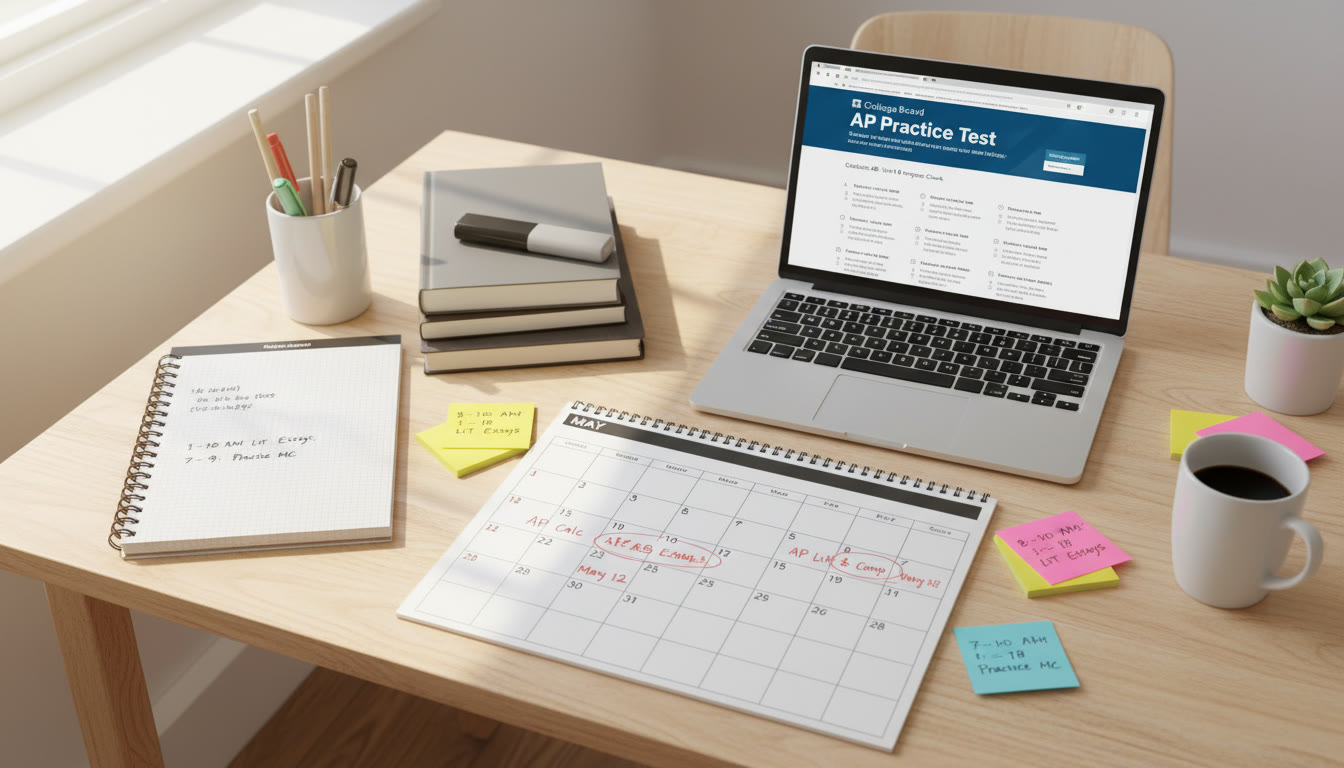Why Backward Planning Beats Last-Minute Cramming
If you’ve ever sprinted through the final week before an AP exam, you know the adrenaline rush of last-minute studying — and the hollow feeling when it doesn’t stick. Backward planning turns that panicked sprint into a confident marathon. Instead of asking, “How do I prepare from today?” you ask, “When do I need to be ready?” and reverse-engineer everything from the exam day itself.

The core idea in one sentence
Start with the AP exam date, subtract the time you need to learn, review, and practice, and then divide that time into manageable, measurable blocks — the kind that build competence and calm.
Map the Terrain: Know Your Exam Dates and Constraints
First things first: get exact exam dates and times for your specific AP courses. College Board posts the annual AP Exam Calendar with the exact days in May (and sometimes early June) when each subject is administered. Schools often schedule exams on specific days within that window. Confirm your school’s assigned dates through your AP coordinator or teacher.
Why this matters: some AP exams — especially language and arts exams or those with performance tasks — have additional deadlines earlier in the spring. Performance tasks for courses like AP Research, AP Seminar, or AP Computer Science Principles often have submission deadlines in April, so those need to be plotted separately.
Checklist: What to collect before you plan
- Your school-assigned AP exam dates and times.
- List of topics and units for each AP course (your syllabus or teacher’s course map).
- Major deadlines (performance tasks, portfolio submissions, accommodation requests).
- Your regular obligations (school schedule, jobs, sports, family events).
- Any planned vacations or conflicts in the two months before exams.
Decide How Much Time You Really Need
Not all AP subjects are created equal. The time you need depends on three things: (1) how familiar you already are with the content, (2) how skill-intensive the exam is (e.g., problem-solving in Calculus vs. timed essay writing in English), and (3) how ambitious your target score is.
Rough time estimates by familiarity and target
Use this as a starting point and tweak it to your history and goals:
| Starting Point | Target Score 3 | Target Score 4–5 |
|---|---|---|
| New to course content | 10–12 weeks | 16–20 weeks |
| Moderately comfortable (covered most units) | 6–8 weeks | 10–14 weeks |
| Strong background or repeating course | 3–5 weeks | 6–8 weeks |
These ranges assume disciplined weekly hours of focused study. If you can only study a little each week, extend the calendar rather than compress it.
Backward Planning in Practice: Build a Timeline
Here’s a practical way to build a backward plan for one AP exam. You can replicate this for multiple exams by overlapping or staggering study blocks as needed.
Step 1 — Mark the Exam Date
Write the exact calendar date and time of your exam in a visible place. Treat it like an immovable appointment — because it is. If your school posts a specific time, use that; otherwise, use the College Board’s scheduled day/time as your anchor.
Step 2 — Block the Final Two Weeks for Intensive Review
Final two weeks = targeted review, timed practice tests, and relaxation strategies to ensure peak performance. This block should include:
- At least two full-length, timed practice exams (simulate testing conditions).
- Focused review of weak topics with active retrieval practice (flashcards, short answer prompts).
- Plan for sleep, nutrition, and logistics (know where and when you’ll test, what to bring).
Step 3 — Set a Practice-Test Schedule Four to Six Weeks Out
Within the month leading up to the test, schedule practice exams every 7–10 days. Use different scoring rubrics for free-response sections and time yourself strictly. After each practice test, spend 2–4 days on targeted remediation.
Step 4 — Allocate the Middle Months for Mastery
If you’re using a 12–16 week plan, the middle months are where you build skill: weekly units, conceptual mastery, and mixed-problem practice. Divide the course syllabus into weekly chunks. Each week should include:
- One to two 50–90 minute focused study sessions on new content.
- One active recall session (flashcards, self-quizzing).
- One mixed-problem or writing practice session.
Step 5 — Reserve the Early Weeks for Foundation
Early weeks are about laying the groundwork: review prerequisite concepts (algebra skills, grammar basics, scientific method), organize your notes, and set up your study environment. If you start early, these weeks can be lighter — which helps you avoid burnout later.
Sample Backward Plan: AP Biology (16-Week Plan)
Below is a sample plan you can adapt for other subjects. The idea is to move backward from the exam date and set milestones you can check off.
| Weeks Before Exam | Focus | Weekly Goals |
|---|---|---|
| 16–13 | Foundations | Review chemistry of life, cell structure, and basic genetics; set up flashcards. |
| 12–9 | Core Concepts | Photosynthesis, cellular respiration, heredity – practice free-response prompts weekly. |
| 8–6 | Integration | Big-picture themes and systems; mixed practice tests and concept mapping sessions. |
| 5–3 | Timed Practice | Full-length practice tests every 7 days; review mistakes and refine exam strategy. |
| 2–0 | Final Review | Light review, two final practice tests, logistics, and rest. No new major topics introduced. |
Daily and Weekly Routines That Actually Stick
Planning is nothing without routines. The best routine is the one you keep. Here’s how to make study routines realistic and resilient.
Build a 7-Day Microcycle
Think in terms of a week: one heavy day, two moderate days, two light days, and two rest/maintenance days. That structure gives both momentum and recovery.
- Heavy Day (2–3 hours): New content + practice problems.
- Moderate Day (1–1.5 hours): Active recall + short practice set.
- Light Day (30–45 minutes): Review flashcards, read summary notes.
- Rest Day: No studying or just fun low-stakes review (e.g., watch a concept video).
Techniques That Improve Retention
- Spaced repetition: Use an SRS or schedule review sessions at increasing intervals.
- Active recall: Close the book and write or speak what you remember.
- Interleaving: Mix problem types in the same study session to train flexibility.
- Self-explanation: Explain concepts to an imaginary student (or a real one).
Practice Tests: Your Most Honest Teachers
Practice exams reveal more than raw score — they show timing issues, weak content clusters, and anxiety triggers. Treat practice tests as experiments: hypothesize what will improve your score, test it, then measure the result on the next practice test.
How to simulate test conditions
- Use a quiet, timed environment with no notes.
- Follow the exam schedule exactly (breaks, timing per section).
- Score your free-response answers with official rubrics when possible.
- Record specific error patterns (e.g., “lost 3 points on data interpretation”).
When You’re Juggling Multiple APs
Lots of students take two or three APs in one season. The trick is deliberate overlap and prioritization.
Rules for multi-AP planning
- Prioritize the exam that’s earliest or the one where your baseline is weakest.
- Stagger full practice tests across weekends so they don’t collide.
- Use mixed-subject short sessions: 25–30 minutes for one subject, then switch to avoid monotony.
- If two exams are the same week, devote the last 10–14 days to alternating focus daily rather than splitting hours equally.
Common Pitfalls and How to Avoid Them
Backward planning reduces surprises, but a few pitfalls still sneak up on students. Here’s how to sidestep them.
Pitfall: Over-ambitious Schedules
Fix: Trim weekly goals until they fit your realistic hours. Consistency beats intensity.
Pitfall: Ignoring Testing Logistics
Fix: Confirm testing room, arrival time, and permitted materials at least two weeks before your exam and pack a test-day kit (photo ID, approved calculator if needed, snacks, water). Knowing these details reduces stress and cognitive load on exam morning.
Pitfall: Failing to Track Progress
Fix: Keep a simple score log for timed practice tests and a separate list of recurring mistakes. If you aren’t improving after several cycles, change strategies — different practice questions, another tutor, or a different study schedule.
How Personalized Tutoring Fits Into Backward Plans
Personalized tutoring can be a force multiplier when integrated thoughtfully into your backward plan. A tutor helps you identify subtle knowledge gaps, accelerate remediation, and refine test strategies.
For students who want targeted support, Sparkl’s personalized tutoring offers 1-on-1 guidance, tailored study plans, expert tutors, and AI-driven insights that track patterns across practice tests. Use tutoring sessions to focus on your stubborn weaknesses — the topics taking up the most time on practice tests — and to practice free-response scoring and timing strategies.
When to bring in a tutor
- After two full practice tests that reveal recurring mistakes.
- When progress stalls despite consistent effort.
- If you need targeted help with free-response scoring or advanced problem-solving.
Sample Weekly Plan With Tutoring (6-Week Ramp for Targeting a 4–5)
Below is a compact six-week ramp for students preparing to boost a score from a 3 to a 4 or 5. The plan uses two tutoring sessions each week for focused remediation.
| Week | Independent Study | Tutoring Focus | Practice Test |
|---|---|---|---|
| 6 | Content review for weak units (4–6 hrs) | Diagnostic review and goal setting | None |
| 5 | Targeted problem sets (4–6 hrs) | Strategy for free-response and timing | Short practice set |
| 4 | Mixed practice and interleaving (5–7 hrs) | Remediation of error patterns | 1 full practice test |
| 3 | Drill weak topics; memory consolidation (5–6 hrs) | Exam simulation techniques | 1 full practice test |
| 2 | Targeted review, light practice (3–4 hrs) | Polishing essays and timing | 1 full practice test |
| 1 | Final light review, rest | Confidence and logistics check | Optional short timed section |
Test-Day Tactics: What Backward Planning Buys You
When you plan backward, test day becomes less about panic and more about performance. Here are practical tactics informed by a backward plan.
- Arrive early: leave contingency time for parking and check-in.
- Warm up with 10–15 minutes of light review (not intensive cramming).
- Start with the section that gives you the most points for the least time.
- Mark hard problems and return if time allows — don’t get stuck.
- Use the last 10 minutes to re-check free-response answers for clarity and completeness.
Adapting Plans When Life Happens
Schedules wobble — sports tournaments, illnesses, family events. Backward planning is resilient because it’s modular. If you miss a week, prioritize the most essential drills: a practice test, a review of recurring mistakes, and one intense remediation session. Recalculate the backward plan from the new date and compress smartly: keep practice-test frequency high, but shorten content-review sessions rather than skipping them entirely.
Quick recovery protocol
- Day 1: Take a short diagnostic (45–60 minutes) to see what changed.
- Day 2–3: Target the top three missed areas with focused sessions.
- Day 4: Resume regular schedule, but add one extra review block per week until you’re back on track.
Measuring Success: Beyond the Score
Scores matter, but process improvements are the reliable signal. Track these metrics as you work through your backward plan:
- Practice-test score trajectory (overall and by section).
- Frequency of repeated mistakes on free-response questions.
- Time-per-question on multiple-choice sections.
- Confidence level and sleep quality during the final two weeks.
Celebrate process wins: a 10% drop in careless errors or a reduction in time-per-problem are signs you’re improving — even if the score climb is gradual.
Putting It All Together: A Mini Case Study
Meet Maya (imaginary but typical). She’s taking AP Calculus AB on May 11. It’s January 20 now. She assigns herself 16 weeks and sets these milestones:
- Weeks 16–12: Reinforce algebra and pre-calculus foundations (two 90-minute sessions/week)
- Weeks 11–8: Finish unit reviews with problem sets (three 60–90 minute sessions/week)
- Weeks 7–4: Weekly full-length practice tests and targeted remediation (practice tests every 7–10 days)
- Weeks 3–0: Final timed practice, logistics planning, and tapering study intensity
Maya uses a tutor twice a week in weeks 7–3 for targeted free-response practice and pacing strategies. She tracks progress in a simple spreadsheet and notices steady improvement in midterm weeks. On test day, she’s calm and executes the plan — not perfect, but confident and prepared.
Final Checklist: Your Backward-Planning Packing List
- Confirmed exam date, time, and location (write it in three places).
- Master calendar with weekly milestones and practice-test dates.
- Short list of recurring mistakes and a targeted remediation plan.
- Test-day kit: ID, approved calculator, pencils, snacks, water.
- Support system: teacher, AP coordinator, and — if you want extra help — a tutoring plan (Sparkl’s tutors can provide scheduleable sessions, personalized study plans, and AI-driven insights to keep your backward plan on track).

Parting Advice: Start Today, Not Tomorrow
Backward planning gives you a map: a clear route from “now” to exam day. It replaces vague hope with specific action. The single best thing you can do right now is to note your exam date, count the weeks, and block the final two weeks on your calendar for review and simulation. From there, create weekly goals that are tiny enough to check off — and big enough to matter.
And remember: smart support multiplies effort. If you hit a wall, personalized tutoring — with one-on-one guidance, tailored study plans, and data-driven feedback — can help you recover time and confidence. Integrate it where it fits your backward plan, and use it to sharpen the parts of your preparation that will move your score the most.
One last thing
AP season is a marathon, not a sprint. The difference between burnout and peak performance is structure: a calendar, a plan, regular practice, and the humility to adjust when something isn’t working. Backward planning gives you the structure; what you bring is steady, honest effort. Do that, and exam day becomes not a leap of faith, but a planned arrival.
























No Comments
Leave a comment Cancel